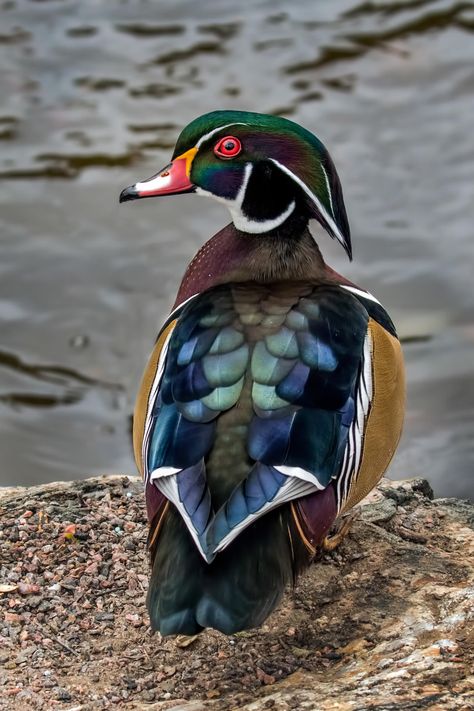The Wood Ducks (Aix sponsa) is a strikingly beautiful and highly distinctive species of duck native to North America. Known for its vivid plumage, unique patterns, and tree-nesting habits, the Wood Duck is a favorite among bird watchers, waterfowl enthusiasts, and conservationists. It’s a perching duck, meaning it prefers to nest in tree cavities near water, often perched above the ground, making it distinct from most other duck species. The Wood Duck is a versatile and adaptable bird, thriving in a variety of habitats, from swamps and wetlands to ponds and riverbanks.
Physical Characteristics
Wood Ducks are medium-sized ducks with distinct and colorful plumage, especially the males.
- Male (Drake):
The drake is especially vibrant and eye-catching:- Head: The head features iridescent green and purple hues, with a striking white “mask” around the eyes and crest.
- Body: The body has a rich mix of chestnut and white feathers with bold black and green patterns. The underbelly is white with bold black and blue markings.
- Bill: The bill is small and red, adding to the colorful appearance.
- Size: Males typically weigh around 1.5–1.9 pounds (680–860 grams) and are about 18–20 inches (46–51 cm) in length.
- Female (Hen):
Females are more muted in coloration but still elegant:- Plumage: They have a more subdued color palette, with grayish-brown feathers and white markings around the eyes and throat.
- Size: Females weigh approximately 1.1–1.4 pounds (500–635 grams) and are slightly smaller than the males.
Habitat and Distribution
Wood Ducks are primarily found in North America, from southern Canada to the southeastern United States and along the western coast. They inhabit wetland environments, such as swamps, marshes, ponds, and rivers, but are often found near wooded areas that provide suitable tree cavities for nesting.
- Tree-Nesting: These ducks are cavity nesters, using tree holes, particularly those near water, to lay their eggs. They are one of the few duck species that will nest in trees rather than on the ground.
- Migration: While some populations are migratory, others in the southern parts of their range may remain year-round.
Behavior and Diet
Wood Ducks are highly adaptable, active, and agile birds, both in the air and on water.
- Diet:
- They are omnivorous, feeding on a variety of plant matter, seeds, acorns, aquatic insects, small fish, and even mollusks.
- Wood Ducks forage in the shallow waters of wetlands, often dabbling or diving for food.
- Social Behavior: They are social birds and often form small groups, especially outside of the breeding season. During migration or winter, larger flocks may gather.
Breeding and Reproduction
Wood Ducks are monogamous, and pairs typically mate for the season, sometimes forming lifelong bonds.
- Nesting:
- Females build nests in tree cavities, using soft materials like feathers and plant matter. If natural cavities are not available, they will readily use man-made nesting boxes.
- The female lays 10–15 eggs, which are incubated for about 28–30 days.
- Ducklings: When the eggs hatch, the mother leads the ducklings to water, where they are quick to swim and dive for food. Ducklings are precocial, able to follow the mother and forage within hours of hatching.
Conservation Status
Wood Ducks were once heavily hunted and faced population declines, but due to conservation efforts, including the installation of nesting boxes and habitat protection, their numbers have rebounded. They are now considered a species of Least Concern by the International Union for Conservation of Nature (IUCN).
Care in Captivity
Wood Ducks are often raised in captivity for ornamental purposes or as part of breeding programs aimed at restoring wild populations.
- Housing: They require a safe, spacious environment with access to water for swimming and foraging. Nesting boxes or tree cavities are essential for successful breeding.
- Diet: A balanced diet of waterfowl pellets, grains, and vegetables ensures their health and vibrant plumage.
Conclusion
The Wood Duck is a breathtaking and fascinating species that captivates bird lovers with its beauty, behavior, and adaptability. Its iridescent plumage, unique nesting habits, and social nature make it one of the most beloved waterfowl in North America. Whether admired in the wild or kept in captivity, the Wood Duck remains a symbol of elegance and resilience.










Reviews
There are no reviews yet.